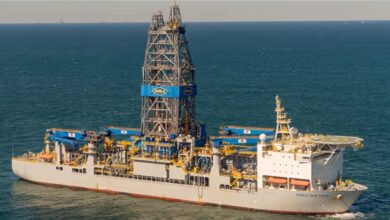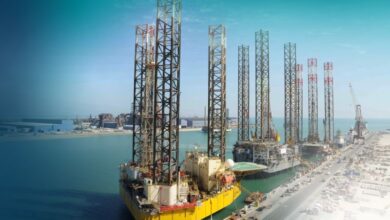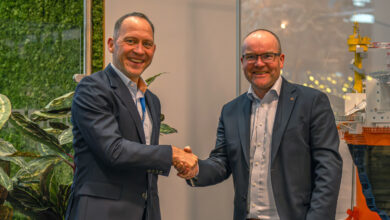Drilling industry must amp up environmental culture to match exceptional safety culture
By Claus V Hemmingsen, Maersk Drilling, 2009 IADC chairman
When I look at where our industry is today, I take great pride in acknowledging the many challenges we have overcome and the milestones we have achieved. Working together, we have developed and adapted new technologies, streamlined our operations and developed a culture of safety that has made our workplaces cleaner and safer.
Now we have a new challenge: visible, actionable environmental stewardship.
As concern mounts about global warming and emissions, and as the industry as a whole seeks to gain recognition as being environmentally responsible, it is time for us to take meaningful action that can make a difference both for our companies and for the communities where we live and work.
Because although we have come a long way in the environmental arena, we still have a way to go.
In the drilling industry, we have a positive history of environmental awareness. Whereas most contractors work hard to avoid spills and reduce emissions, we’re not quite there yet. Reduce, reuse and recycle should perhaps become the motto by which we operate.
Equipment, and the technology behind it, is continually being evaluated in the design of new rigs. We have put in place procedures for blowout and spill prevention, and our maintenance programs are more advanced to ensure the integrity of our equipment. In addition to creating more energy-efficient pumps, machinery is continually being improved to reduce CO2 emissions.
Many companies, such as Transocean, have put environmental management systems (EMS) in place and are certified according to ISO 14001.
But while our awareness goes very deep and is very actionable when it comes to preventing and avoiding direct pollution like oil spills and oil-based mud spills, when it comes to the more subtle emissions and energy consumption, I think we still need to go a step deeper and do something more. In other words, the commitment is strong, but the actions are not as profound, or at least not very visible.
We have, over time, developed an extraordinary safety culture, but when it comes to the environment, that strong culture is lacking. I believe our goal should be to create an environmental culture that matches the safety culture and record we have achieved.
How do we move forward with this ambitious initiative? The place to start is with an industrywide benchmark that would enable us to measure our environmental efforts and compare ourselves to one another. This would create high standards for our industry and would foster increased awareness and observation of what companies can do. It would put incentives on all of us to do what we can to put action behind our commitment and generate awareness of our efforts outside the industry.
This is an area where IADC can play a key role. It can’t be individual companies touting their accomplishments. Whereas the motivation has to come from our members, IADC can consolidate and facilitate an industry view. When members of IADC decided to do something about safety performance, we created reporting standards and benchmarking among the members. Clearly, something started to happen, and over the last 25 years, IADC members have come a long way in improving our safety performance. Now, the job for IADC is to create that same openness to these ideas for the environment, and to assist in establishing standards and guidelines for members.
Secondly, we need systems for reporting environmental efforts. This would facilitate transparency, guarantee similarity in standards and help us communicate the results of our efforts so we can improve the overall image of the industry.
Some companies already have reporting systems in place. Noble Drilling has been publishing sustainability reports since 2002. At Maersk Drilling, we have developed a system of reporting and last year produced our first environmental report using a software program that allows us to report all incidents, list the actions to be taken and measure the progress of our actions. The program also includes risk management tools.
Equally important is cooperation with the operators, our clients, to achieve a high level of environmental performance. Because operators prescribe power consumption and supply the fuel, there needs to be mutual cooperation on the projects related to fuel consumption. If we don’t get this buy-in and traction with the client, drilling contractors will have to lean out and implement things they are not necessarily rewarded for. We need our clients to participate in order to progress.
These efforts will require companies to engage in systematic, deliberate processes that will evolve over time. I think this will happen with gradual, incremental changes that will have to come together in order to make a big impact on the way we operate.
At Maersk, for example, we have made great strides in our reporting system and HSE training of subcontractors, including specific training on how to avoid environmental incidents such as oil spills in the marine environment. We have created a customer satisfaction survey that covers environmental issues. We have also joined the United Nations Global Compact, which addresses the environment in its 10 parameters.
Maersk’s Green Rig Project, launched 1 January this year, targets four main issues: energy efficiency and emissions, discharge, accidental spills and waste management. The purpose is to enhance eco-efficiency by synergy in line with the HSE safety procedures. In time, the aim is to create overall benchmarks on environmental performance, explore potential improvements in technology and get people as focused on environmental issues as they are when it comes to safety matters. But it’s really about engaging employees and getting traction so that we get a buy-in for the initiatives we roll out.
Still, our company needs to be more ambitious in terms of setting goals for future improvements. Industrywide benchmarks and standardized reporting procedures would make this goal more easily attainable.
Last year, IADC established the Environmental Policy Advisory Panel (EPAP), designed to be a forum for senior management from drilling contractor companies to guide our members on strategies, actions and policies on the environment. The panel is also charged with reaching out to operators and other stakeholders and to improve, through real performance, our industry’s image and reputation in environmental preservation, protection and citizenship.
We have set out the objectives, but so far, the panel’s role has been very limited as we are in the very early stages of bringing the working committee to life. We are now putting together a more solid and more active work group to get some things done that we have on the ideas list.
It is my hope that the two-day Environmental Conference & Exhibition in Stavanger, Norway, on 12-13 May, will serve as way to showcase this panel, as well as provide an opportunity, through the wide range of workshops and discussions we have planned, for our members to become aligned on this issue, as they are on safety. As a trade association, we cannot start talking about standards without our members having had a prior discussion about what those standards should be.
I believe the most important thing we can do right now is to agree on a reporting regime so we can benchmark in the industry, both for use amongst ourselves and to change the perception of the public.
The challenge before us is an urgent one and is one we cannot afford to ignore. As we have done in the past, I believe we can meet this challenge by taking a leadership role to create a record of environmental stewardship that will become a model for our industry and make a difference in sustaining our world for generations to come.
Claus V Hemmingsen is CEO of Maersk Drilling and a partner at AP Moller-Maersk.




